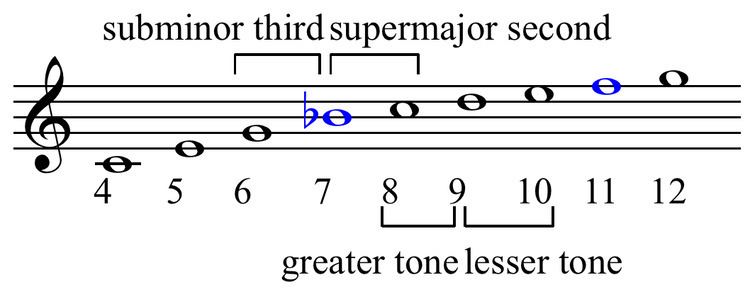 | ||
In music, a subminor interval is an interval that is noticeably wider than a diminished interval but noticeably narrower than a minor interval. It is found in between a minor and diminished interval, thus making it below, or subminor to, the minor interval. A supermajor interval is a musical interval that is noticeably wider than a major interval but noticeably narrower than an augmented interval. It is found in between a major and augmented interval, thus making it above, or supermajor to, the major interval. The inversion of a supermajor interval is a subminor interval, and there are four major and four minor intervals, allowing for eight supermajor and subminor intervals, each with variants.
Contents
Traditionally, "supermajor and superminor, [are] the names given to certain thirds [9:7 and 17:14] found in the justly intoned scale with a natural or subminor seventh."
Subminor second and supermajor seventh
Thus, a subminor second is intermediate between a minor second and a diminished second (enharmonic to unison). An example of such an interval is the ratio 26:25, or 67.90 cents (D- Play ). Another example is the ratio 28:27, or 62.96 cents (C♯- Play ).
A supermajor seventh is an interval intermediate between a major seventh and an augmented seventh. It is the inverse of a subminor second. Examples of such an interval is the ratio 25:13, or 1132.10 cents (B♯); the ratio 27:14, or 1137.04 cents (B Play ); and 35:18, or 1151.23 cents (C Play ).
A subminor third is in between a minor third and a diminished third. An example of such an interval is the ratio 7:6 (E♭), or 266.87 cents, the septimal minor third, the inverse of the supermajor sixth. Another example is the ratio 13:11, or 289.21 cents (E↓♭).
A supermajor sixth is noticeably wider than a major sixth but noticeably narrower than an augmented sixth, and may be a just interval of 12:7 (A). In 24 equal temperament A = B. The septimal major sixth is an interval of 12:7 ratio (A Play ), or about 933 cents. It is the inversion of the 7:6 subminor third.
A subminor sixth or septimal sixth is noticeably narrower than a minor sixth but noticeably wider than a diminished sixth, enharmonically equivalent to the major fifth. The sub-minor sixth is an interval of a 14:9 ratio (A♭) or alternately 11:7. (G↑- Play ) The 21st subharmonic (see subharmonic) is 729.22 cents. Play
A supermajor third is in between a major third and an augmented third, enharmonically equivalent to the minor fourth. An example of such an interval is the ratio 9:7, or 435.08 cents, the septimal major third (E). Another example is the ratio 50:39, or 430.14 cents (E♯).
A subminor seventh is an interval between a minor seventh and a diminished seventh. An example of such an interval is the 7:4 ratio, the harmonic seventh (B♭).
A supermajor second (or supersecond) is intermediate to a major second and an augmented second. An example of such an interval is the ratio 8:7, or 231.17 cents, the septimal whole tone (D- Play ) and the inverse of the subminor seventh. Another example is the ratio 15:13, or 247.74 cents (D♯).
Use
Composer Lou Harrison was fascinated with the 7:6 subminor third and 8:7 supermajor second, using them in pieces such as Concerto for Piano with Javanese Gamelan, Cinna for tack-piano, and Strict Songs (for voices and orchestra). Together the two produce the 4:3 just perfect fourth.
19 equal temperament has several intervals which are simultaneously subminor, supermajor, augmented, and diminished, due to tempering and enharmonic equivalence (both of which work differently in 19-ET than standard tuning). For example, four steps of 19-ET (an interval of roughly 253 cents) is all of the following: subminor third, supermajor second, augmented second, and diminished third.
